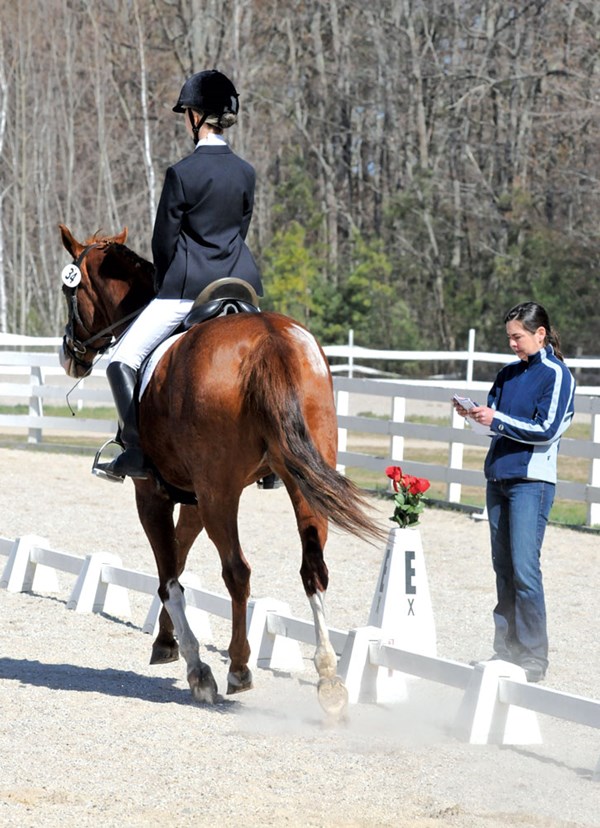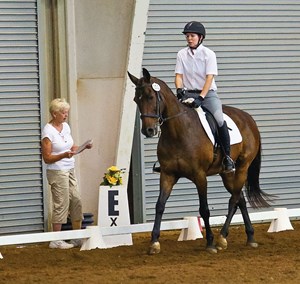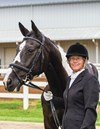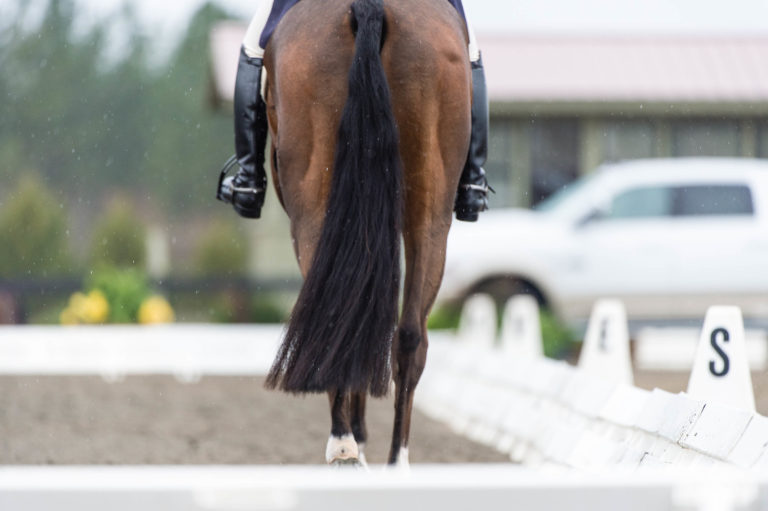
At some point in your dressage rider’s career, you will be asked to call a test for a fellow rider who is ready to go down centerline at a show. As a USEF “r” dressage technical delegate and USDF “L” Education Program graduate, I have seen my share of dressage tests read. Based on experience, I can tell you that if you are not already an accomplished test reader, a few pointers can make the experience more positive for both you and the rider. Below, I will cover the most important prerequisites and rules.
Are You Ready for This?
If you can read a dressage test and have a strong voice that carries, you are probably qualified to become a dressage test reader. However, there are some other things to consider before accepting certain requests. For example, do you have experience with the particular dressage test in question? The more familiar you are with the general flow, the easier it will be for you to read a test.
Though you aren’t showing, reading a test can be mentally challenging. Consider your emotional connection to the competitor. Perhaps you shouldn’t read for your family members or close friends if it makes either of you feel stress. Regardless of your relationship to the competitor, confirm that you are tough enough to handle her reaction afterward if she has a poor test.
Also consider your own circumstances and level of concentration. For example, if you are riding your own horse at the same show, you might be too distracted to read.
If you think you have the qualities to be a good reader, then consider starting at a local schooling show. The low-key nature will take some of the pressure off. After practicing at schooling shows, you will surely be ready to read at a recognized show, where there is typically much more pressure and tension.
Test Prep
Before you head to the show, be sure you have the current tests. They change every four years and are available in commercial booklets that include all tests from the USEF and USDF websites. Smartphone applications have recently become an option. Review the test ahead of time to make sure that you know the geometry involved. A simple practice read-through helps you know where the rider is going in the ring as well as the sequence of the movements.
Portions of some tests are quite wordy, and at some points you might have almost no time to read everything before the next movement starts. In other tests, you may be silent for what seems like a long time between movements. Knowing this ahead of time will help you read the test well and be an asset to the rider.
Hopefully you know the rider for whom you are reading and whether she wants each movement read long in advance (before she has finished the previous movement) or if she wants it read only five to 10 strides out. Part of this depends on the show and riding experience of the rider, as the further out from the movement you read, the more time she has to prepare. However, if you read the next movement too early, and the rider is still focusing on finishing the half pass, she might not hear you say “F–X–H medium trot.”
Show Day

When packing for show day, bring a copy of the test with you. The rider usually has a test or book from which you can read, but make sure someone has the appropriate test.
If rain is imminent and the tests are being ridden outdoors, be sure that you have a plastic bag or something water-resistant in which you can place the test. Wear a rain hat and/or raincoat rather than carry an umbrella that you would have to juggle and control while you read.
When you arrive at the dressage competition, make sure you know which ring your rider is showing in. Sometimes both the reader and the rider are confused as to which ring is the correct one, or the ring times/schedule may have changed since the initial ride times were posted. At shows with multiple rings, be sure you know how to get down to the ring. (Sometimes there is only one way to get to the arenas; at others, what appear to be the logical paths may be blocked off.)
Make sure your ring is running on time. Although the rider is not required to ride before her scheduled ride time, judges sometimes get behind or accidents happen that delay the show. Time changes will affect the rider’s warm-up as well as when you should arrive ringside to read. Most of the time the rider will look to her reader or groom for this information, so be sure to check with the in-gate steward about any changes or delays.
Know the competition number of the horse in front of your rider. This will help ensure that you are ready at the right moment regardless of the scheduled ride time.
Confirm the test your rider will be riding. Make sure the test your rider is planning on riding matches what the in-gate person and program say. Sometimes tests get scheduled out of order, and the rider may not know that she is actually riding Test 3 before Test 2. As the rider circles the arena, it is always a good idea to recite “Training Level, Test 1” or whatever the person is riding so that you both confirm the upcoming test. There is nothing worse than reading the wrong test.
Make sure that as you walk up to the dressage ring, you have the correct test open in your book or on your smartphone application.
Although there is no set place in the ring from which a test is required to be read, B and E are the normal locations for readers. If there is little distance between two rings, opt to read from the side farthest from the other ring.
Know what you are listening for to begin reading. If you begin reading at the wrong signal (bell instead of whistle), your rider may end up in the ring before her signal has sounded, risking elimination.
As you read, be sure to follow the test with your finger so that when you look up to see where the rider is in the test, you can easily find your place to continue reading.
If you find that you are reading the wrong test, quickly flip to the correct test or just stop reading and remain in place until the rider finishes the ride.
Although it is always the rider’s responsibility to know the test, the reader is an asset in that if the rider is momentarily confused, the reader can direct her through creative test reading. For example, for a walk from H to X to K, if the rider is making no effort to change direction at X (because she thinks she is doing the H–X–F diagonal), just before she reaches X, read “K” emphasized loudly “medium walk” so she can quickly correct her line of travel. The same thing can be done when a rider does a 15-meter circle instead of a 10-meter circle. Before the second circle, the reader can read “B 10-meter circle” and the rider will get the idea.
Be sure that you enunciate clearly, as “B” and “E” sound very similar, especially with noise from fans, squeaky boots on the saddle or other readers. As you read, look directly at your rider (not at the test book) to project your voice toward her and not to the rider in the other ring or into the ground.
Also be sure to project your voice appropriately for the conditions of the arena. You may have to almost shout to be heard over fans in an indoor or winds outside.
However, if you are in an arena with very little noise, yelling or using a strident voice is very annoying to the judge and scribe who have to sit there all day trying to tune out the sound of readers.
With all these thoughts in mind, you can be an asset to riders. A good reader will be asked to read tests. Just remember that your attention must be on the test in front of you until you read that final “X, Halt, Salute.”
Test Reading Frequently Asked Questions
• When do I start calling? At the beginning of the test. For instance, you can’t show up in the middle of the test and begin reading.
• What am I allowed to read from the test? Only what is written on the test sheet, and portions of the test might be marked not to be read.
• Can I call the test in a different language? Only call the test in English unless you have permission to read in another language.
• What if I need to speak to the competitor or she says something to me? You cannot talk to the rider during the test or give instructions, as this is “unauthorized assistance” and can result in elimination of the rider from the test.
• Can I repeat a movement? No. Don’t reread a movement unless it is very clear that a sound or disturbance might have caused your voice not to be heard.
• What should I do if my rider goes off course? The judge may signal the rider to stop and tell her where to restart the test. During this time, as the reader, you are to remain silent; once the rider has resumed the test, you can continue reading where you left off.
Susan Lang is a USDF “L” Education Program graduate as well as a USEF “r” dressage technical delegate who lives in Kansas. She is past president of the Kansas Dressage and Eventing Association (KDEA) and current vice president and chair of competition management for KDEA. She competes as an Adult Amateur at Third Level on her pinto Dutch Warmblood gelding, Peter Pan.












